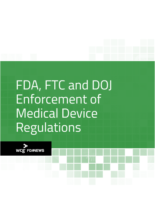
Home » What Device Manufacturers Can Learn From FDA’s Inspection Data
What Device Manufacturers Can Learn From FDA’s Inspection Data
Medical device quality managers that don’t want to wind up a statistic in a future FDA report on quality deviations should dig deeply into the agency’s recently released report on inspections, Form 483s and warning letters, says Michael Gaba, a partner in the law firm Polsinelli.
The agency released CY2016 Annual FDA Medical Device Quality System Data
Inspections, FDA Form 483 Observations, and Warning Letter Citations, says Gaba, to give companies a peek into data collected by the FDA during inspections so they can see what’s happening across the regulated industry.
The report “lets you see trends, which can show you potential problems that you should be focusing on because the odds are that you too will find yourself in the same bucket of deviations,” says Gaba, who will present an FDAnews webinar on lessons from the FDA report August 9.
For example, he says, it’s helpful for foreign companies to know foreign inspections increased while domestic inspections decreased. It’s also helpful to know that foreign companies got slapped with an Official Action Indicated (OAI) after an inspection 12 percent of the time, when domestic companies got OAIs 7 percent of the time.
“U.S. companies seem to be doing a better job getting it right,” says Gaba, which he added may be a function of their having been in the market and subjected to FDA regulations for longer.
Companies in China, Germany and the United Kingdom should take heed, as they are the companies most often getting OAIs.
In 2016, FDA issued 854 Form 483s, and 3,027 Form 483 observations were cited for 21 CFR 820 (Quality System regulation) deficiencies. Two thirds of those observations fell into the categories of Corrective and Preventive Action (CAPA) and Production and Process Controls (P&PC). CAPA and P&PC continue to be the most frequently observed and cited quality subsystems. So companies, take heed, says Gaba.
“That shows exactly where companies should be spending more energy,” he says.
As part of CAPA, device companies are required to perform regular internal quality audits, and the FDA’s 2016 report showed many of them were not doing that, says Gaba. That transgression garnered the highest level of warning letters (79 percent). Companies should take that as a warning that not only will they get a slap on the wrist for not conducting quality audits, but if they’re not looking closely at their quality systems, they’re going to pay a large cost later, says Gaba.
“An investment in quality helps reduce time spent dealing with compliance shortcomings, so everybody benefits — the public because they now have products of a higher quality, and agency, which doesn’t have to use as many resources to fix problems,” says Gaba. “If you emphasize quality with an eye on the patient as the ultimate customer, and you’re doing your job well, compliance follows.”
Gaba notes the CDRH intends its complaint requirements to be a floor, not a ceiling. The hope is that companies will meet the requirements as a minimum, then go much further with quality.
Overall, the FDA report shows, 483s were down in 2016, and all quality subsystems saw a drop in the number of 483 observations. That’s a very good thing, says Gaba.
“This supports the notion that this push for quality over the last several years is having an impact,” and a big part of the success is the release of these data each year, he says.
Upcoming Events
-
07May
-
14May
-
30May

